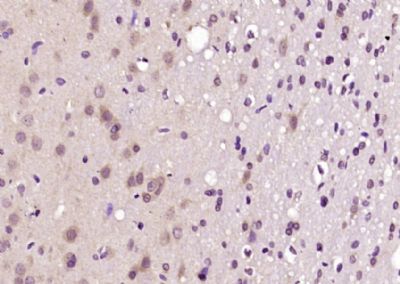FEZ1 Polyclonal Antibody
Purified Rabbit Polyclonal Antibody (Pab)
- SPECIFICATION
- CITATIONS
- PROTOCOLS
- BACKGROUND

Application
| WB, IHC-P, IHC-F, IF, E |
|---|---|
| Primary Accession | Q99689 |
| Reactivity | Rat, Pig, Dog, Bovine |
| Host | Rabbit |
| Clonality | Polyclonal |
| Calculated MW | 45 KDa |
| Physical State | Liquid |
| Immunogen | KLH conjugated synthetic peptide derived from human FEZ1 |
| Epitope Specificity | 301-392/392 |
| Isotype | IgG |
| Purity | affinity purified by Protein A |
| Buffer | 0.01M TBS (pH7.4) with 1% BSA, 0.02% Proclin300 and 50% Glycerol. |
| SUBCELLULAR LOCATION | Cytoplasm, cytoskeleton, centrosome. Cellmembrane (By similarity). Note=Co-localizes with both, alpha- andgamma-tubulin. Translocated from the plasma membrane to thecytoplasm by activation of the PKC zeta (By similarity). |
| SIMILARITY | Belongs to the zygin family. |
| SUBUNIT | Homodimer; difulfide-linked. May form heterodimers withFEZ2. Interacts with the NH2-terminal variable region (V1) of PKCzeta and weakly with that of PKC epsilon (By similarity). Interactswith UBE4B. Interacts with SAP30L. Interacts with SCOC and ULK1;SCOC interferes with ULK1-binding to FEZ1. Directly interacts withSCOC and UVRAG. Stabilizes the interaction between SCOC and UVRAGduring amino acid starvation. |
| Post-translational modifications | Phosphorylated by protein kinase C zeta; which enhancesinteraction with UBE4B and polyubiquitination.Polyubiquitinated in a UBE4B-dependent manner; which does notlead to proteasomal degradation and may be important for neurogenicactivity. Polyubiquitin linkage seems to be mainly through Lys-26. |
| Important Note | This product as supplied is intended for research use only, not for use in human, therapeutic or diagnostic applications. |
| Background Descriptions | Frequent loss of heterozygosity (LOH) at human chromosome 8p22-p21 is associated with various tumors including prostate and breast cancer. The 8p22-p21 region contains the FEZ1 gene, which is altered in tumors of the esophagus, prostate and breast. The FEZ1 protein (also known as leucine zipper putative tumor suppressor or LZTS1) contains a DNA-binding leucine zipper motif. FEZ1 is expressed in normal breast and prostate, but alterations in FEZ1 expression result in abnormal cell growth. The absence of FEZ1 expression is characteristic of breast and prostate cancer cell lines as well as primary breast and pro-state tumors. This absence of FEZ1 may be due to several factors, including mutations in the FEZ1 gene or hypermethylation of the CpG island flanking the FEZ1 promoter region. FEZ1 acts as a negative regulator of cell growth. During cell-cycle progression, FEZ1 localizes to microtubule components and is hyperphosphorylated by cAMP-dependent kinase. |
| Gene ID | 9638 |
|---|---|
| Other Names | Fasciculation and elongation protein zeta-1, Zygin I, Zygin-1, FEZ1 |
| Target/Specificity | Mainly expressed in brain. |
| Dilution | WB=1:500-2000,IHC-P=1:100-500,IHC-F=1:100-500,IF=1:50-200,ELISA=1:5000-10000 |
| Format | 0.01M TBS(pH7.4), 0.09% (W/V) sodium azide and 50% Glyce |
| Storage | Store at -20 ℃ for one year. Avoid repeated freeze/thaw cycles. When reconstituted in sterile pH 7.4 0.01M PBS or diluent of antibody the antibody is stable for at least two weeks at 2-4 ℃. |
| Name | FEZ1 |
|---|---|
| Function | May be involved in axonal outgrowth as component of the network of molecules that regulate cellular morphology and axon guidance machinery. Able to restore partial locomotion and axonal fasciculation to C.elegans unc-76 mutants in germline transformation experiments. May participate in the transport of mitochondria and other cargos along microtubules. |
| Cellular Location | Cytoplasm, cytoskeleton, microtubule organizing center, centrosome. Cell membrane. Note=Colocalizes with both, alpha- and gamma-tubulin Translocated from the plasma membrane to the cytoplasm by activation of the PKC zeta (By similarity). |
| Tissue Location | Mainly expressed in brain. |

Thousands of laboratories across the world have published research that depended on the performance of antibodies from Abcepta to advance their research. Check out links to articles that cite our products in major peer-reviewed journals, organized by research category.
info@abcepta.com, and receive a free "I Love Antibodies" mug.
Provided below are standard protocols that you may find useful for product applications.
If you have used an Abcepta product and would like to share how it has performed, please click on the "Submit Review" button and provide the requested information. Our staff will examine and post your review and contact you if needed.
If you have any additional inquiries please email technical services at tech@abcepta.com.













 Foundational characteristics of cancer include proliferation, angiogenesis, migration, evasion of apoptosis, and cellular immortality. Find key markers for these cellular processes and antibodies to detect them.
Foundational characteristics of cancer include proliferation, angiogenesis, migration, evasion of apoptosis, and cellular immortality. Find key markers for these cellular processes and antibodies to detect them. The SUMOplot™ Analysis Program predicts and scores sumoylation sites in your protein. SUMOylation is a post-translational modification involved in various cellular processes, such as nuclear-cytosolic transport, transcriptional regulation, apoptosis, protein stability, response to stress, and progression through the cell cycle.
The SUMOplot™ Analysis Program predicts and scores sumoylation sites in your protein. SUMOylation is a post-translational modification involved in various cellular processes, such as nuclear-cytosolic transport, transcriptional regulation, apoptosis, protein stability, response to stress, and progression through the cell cycle. The Autophagy Receptor Motif Plotter predicts and scores autophagy receptor binding sites in your protein. Identifying proteins connected to this pathway is critical to understanding the role of autophagy in physiological as well as pathological processes such as development, differentiation, neurodegenerative diseases, stress, infection, and cancer.
The Autophagy Receptor Motif Plotter predicts and scores autophagy receptor binding sites in your protein. Identifying proteins connected to this pathway is critical to understanding the role of autophagy in physiological as well as pathological processes such as development, differentiation, neurodegenerative diseases, stress, infection, and cancer.



